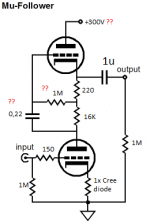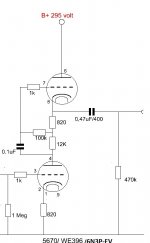I found this pic on the web, think it's from tubecad. Is the 0,22uf cap and 1M res legit in my configuration with russian 6n3p tubes?
Shoog: You didn't mention anything about this values? That's why i thought maybe this is not a mu-follower. I read also on tubewizard and they also said that there was two different ways to take out the signal. I guess i got little confused.
Shoog: You didn't mention anything about this values? That's why i thought maybe this is not a mu-follower. I read also on tubewizard and they also said that there was two different ways to take out the signal. I guess i got little confused.
Hi,
I'll do the math for you later on today if you like.
B+ 300VDC at top anode, correct?
Ciao,
Shoog: You didn't mention anything about this values?
I'll do the math for you later on today if you like.
B+ 300VDC at top anode, correct?
Ciao,
Looks good to me.
You can try taking it off the cathode of the top tube, and then try taking it off the anode of the bottom and see which you like best.
Shoog
Ok, thx
Hi,
I'll do the math for you later on today if you like.
B+ 300VDC at top anode, correct?
Ciao,
I have about 280V now but release drop i think i can easy get 300+. I just thinking shoog said "little more" that made me just think 300
That would be super
Today i converted my SRPP to Mu-follower.
My music-pc decided to take a dive into "black" screen land so i didn't get more than 2-3 h of sweet music but one thing is for sure. I have a certain calm approach from top to bottom i haven't heard in my system before meanwhile voices are upfront. With SRPP it was a little nervous, light aggressive sound and everything was upfront. Now it's more front-to-back perspective. Quite nice to hear a piano sound effortless further away while the singer is in my lap
I had to turn my bassamp some 0,3-0,5db down to get a better overall sound cos mu-follower gave me more bass (but same quality as before if not little bit better)
Thx alot to Frank for providing me with a schematic and help along the way.
When I'm writing this i really feel addictive to mu-follower, maybe that says enough
My music-pc decided to take a dive into "black" screen land so i didn't get more than 2-3 h of sweet music but one thing is for sure. I have a certain calm approach from top to bottom i haven't heard in my system before meanwhile voices are upfront. With SRPP it was a little nervous, light aggressive sound and everything was upfront. Now it's more front-to-back perspective. Quite nice to hear a piano sound effortless further away while the singer is in my lap
I had to turn my bassamp some 0,3-0,5db down to get a better overall sound cos mu-follower gave me more bass (but same quality as before if not little bit better)
Thx alot to Frank for providing me with a schematic and help along the way.
When I'm writing this i really feel addictive to mu-follower, maybe that says enough
Last edited:
Hi,
You're welcome.
So. how is the bottom triode biased then? Cree diodes or plain resistor?
Sorry to hear about the PC.
Ciao,
Thx alot to Frank for providing me with a schematic and help along the way.
You're welcome.
So. how is the bottom triode biased then? Cree diodes or plain resistor?
Sorry to hear about the PC.
Ciao,
Hi,
Bias is set at different value. Measure the voltage drop across the Rk resistors and maybe there are some red LEDs that would give about the same amount of forward voltage drop.
I haven't looked though.
Still, enjoy it first like this, you can always change later on so you then have a better reference to compare.
I did receive your e-mail.
Ciao,
Bias is set at different value. Measure the voltage drop across the Rk resistors and maybe there are some red LEDs that would give about the same amount of forward voltage drop.
I haven't looked though.
Still, enjoy it first like this, you can always change later on so you then have a better reference to compare.
I did receive your e-mail.
Ciao,
You can parallel LEDs.
That could give you more current handling but it won't change the voltage. Then you run into the trouble of current sharing between devices.
Hi,
In series would work .
Ciao,
Obviously.... assuming that much bias was required. The problem with LED's is that you are stuck with their forward voltage as the minimum bias for the tube. If you don't need that much bias, or if you are not running enough DC current through the tube, then they are useless. LED's won't work with the 1mA typically drawn by a 12AX7 for example, or if you want to run the tube at some micro voltage and current. I don't like to be tied to a specific bias voltage so I am not a big fan of LED bias. I fully understand the reasoning behind using them, just that they have their own limitations which no one seems to talk about. Everything has a plus or minus going for it. Real engineering is about balancing those in view of the goal for the circuit.
Also note that LED's have a maximum DC current they can handle, which can be easily exceeded in some situations.
Yet another consideration is the fact that you are intending to connect this LED to a red hot cathode. It's going to get warm. You have to derate the current handling ability for the LED by the anticipated rise in temperature for the device in operation. Even further, you have to take into consideration the peak plate current because if you exceed the derated current carrying ability of the LED then I assume you get into a non-linear region for the device and who knows what happens then.
Of course, the same can be said for battery bias regarding fixed voltages (assuming you're using a real battery of course).
Last edited:
- Status
- This old topic is closed. If you want to reopen this topic, contact a moderator using the "Report Post" button.
- Home
- Amplifiers
- Tubes / Valves
- My first preamp with tubes

